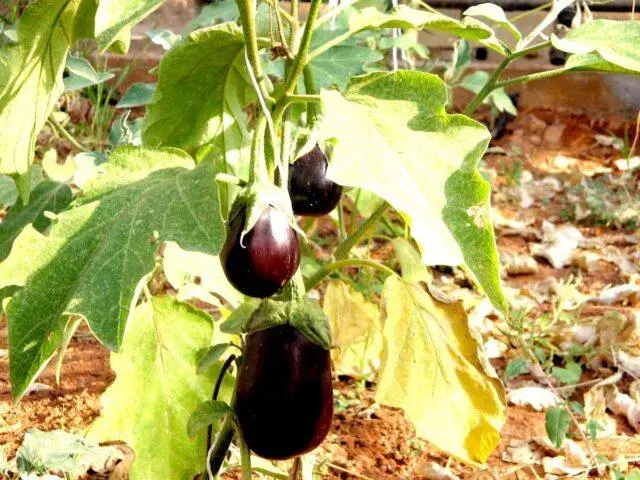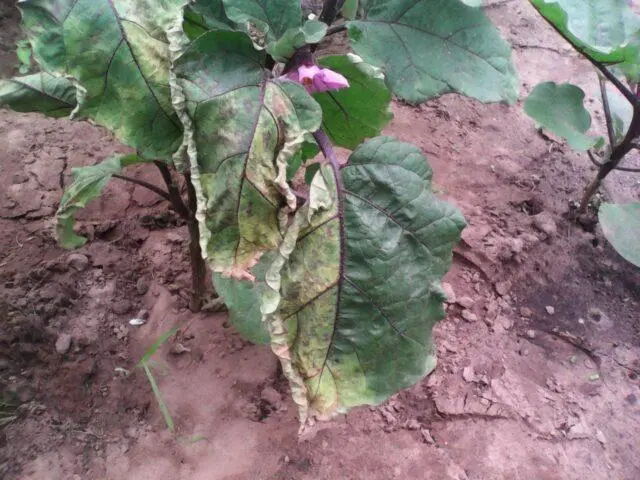Contents
Eggplant leaves turn yellow in the greenhouse for a variety of reasons. Often this can be due to inclement weather or stress after transplantation. But most often this phenomenon is observed due to improper care, for example, violation of the irrigation rate or irregular fertilization.
Why did the eggplants turn yellow in the greenhouse
The greenhouse creates a special environment with its own microclimate. On the one hand, the plants will not suffer from temperature changes, sudden cold snaps at night. Eggplants are quite demanding and grow well only in the range of 23-27 degrees. It is much more difficult to provide such conditions in open ground.
But greenhouses also have disadvantages associated with insufficient light levels, high humidity and stagnant air. Combined with infertile soil and maintenance errors, this causes the leaves to turn yellow. If the problem is not solved in time, the bushes will suffer greatly, which will inevitably affect the yield.
In practice, it is very important to learn how to determine the cause of the yellowing of eggplant. Most often they are associated precisely with improper care of plants in the greenhouse. The main factors are described below.
stress after transplant
If eggplant leaves turn yellow after transplanting into a greenhouse, the cause may be related to post-transplant stress. This is especially often observed in cases where summer residents are in too much of a hurry and plant seedlings already in early May. Even when growing in a greenhouse, this should be done only in the middle or in the second half of the month.
If at night the temperature drops below 12 degrees, the seedlings are covered with a film. If necessary, the greenhouse is additionally heated. So that the leaves do not turn yellow, when transplanting, it is important to preserve the earthen lump to the maximum, after watering the soil in the container. You can also use peat pots, which are simply placed in the hole without touching the roots.
Unsuitable soil
Yellow leaves of eggplants in a greenhouse also appear due to infertile soil. Plants are quite demanding, they develop well only on fertile soils with a loose, loose structure. Loam with a neutral reaction (pH in the range of 6-7) is optimal. If the soil is depleted, it must be prepared. Work begins at least two months before transplantation. So that the eggplant leaves do not begin to turn yellow, organic matter (compost, humus) must be added to the soil.

Eggplant leaves may turn yellow due to growing in poor, dense soil.
The thickened landing
There is almost always not enough space in the greenhouse, but still, seedlings should not be planted too tightly. Between them it is necessary to leave 30-35 cm or more. Typically 1m2 accommodate up to five plants. Otherwise, the leaves will turn yellow, and other unpleasant consequences are possible:
- The soil doesn’t dry out.
- Due to the high humidity, fungi and bacteria are activated.
- The roots will begin to rot.
- It will be more difficult to take care of the plants, for example, it will be difficult to get to the soil and loosen it.
- In the greenhouse, eggplants will not have enough light.
- Due to the fact that the leaves begin to turn yellow, fewer ovaries are formed, so the yield will noticeably decrease.
Root damage
In the greenhouse, the leaves may also turn yellow due to damage to the roots. This can happen in two cases – when transplanting and loosening the soil. To avoid the problem, it is necessary to pre-water the containers (for 1-2 days) in order to form an earthen clod. Then transfer the seedlings of seedlings by transshipment, trying not to touch the roots.
When loosening, you should use tools, for example, small rakes. The surface layer is dug up to a depth of no more than 5 cm, so as not to damage the roots. Otherwise, the harm from such a procedure will be more than good.
Incorrect watering
Often, the reasons why the eggplant leaves in the greenhouse turned yellow are associated with improper watering. Summer residents can give too much water, besides, the summer is rainy. Therefore, it is important to follow the weather forecast and water in moderation, avoiding severe waterlogging. In a greenhouse, it is especially important to monitor the condition of the soil – it should remain slightly moist.
If there is too much water, the leaves will not turn yellow, but then the roots will begin to rot. In addition, in conditions of high humidity, bacteria, fungi and other pests spread rapidly.

Eggplant foliage may turn yellow due to dry soil
Lack or excess nutrition
When grown in a greenhouse, it is recommended to fertilize 3-4 times per season. Even if the soil is fertile, eggplants still need top dressing. Immediately after transplantation, the emphasis is on nitrogen compounds, and during flowering and the formation of ovaries, they give mainly superphosphates and potassium, for example, in the form of sulfate.
Usually top dressing is done after transplantation, during the formation of buds, ovaries, and then at the fruiting stage. But if there are not enough nutrients, it is recommended to make an extraordinary top dressing. When grown in a greenhouse, eggplants are carefully inspected. You can identify the signs of deficiency by external symptoms. For example, with a lack of nitrogen:
- the leaves begin to turn yellow, turn pale, there are very few of them, they become smaller;
- growth is greatly slowed down;
- shoots become thinner;
- inflorescences will be small.
With a lack of potassium, the symptoms are:
- the leaves will become bluish-green, duller;
- they can also bronze a little;
- after that, part of the foliage will turn yellow, covered with a brown tint;
- along the edges of the sheet plates are twisted.
With a lack of phosphorus, the symptoms are about the same as in the case of nitrogen deficiency. The leaves will turn yellow and fall off, the shoots will thin out. In this case, the foliage can also become dark green, with a bluish tint. Often, eggplant lacks several elements at once, so it is better to feed with complex fertilizer.
Temperature differences
Due to temperature changes, even in a greenhouse, eggplant leaves may begin to turn yellow. In some regions, summers are cool and rainy, the climate is quite harsh.
A situation is considered dangerous when it was hot during the day (+30 degrees and above), and at night the temperature dropped below +15. If such weather is observed for several days in a row, the foliage will turn yellow and fall off. Therefore, additional protection measures should be taken – shading, shelter for the night.

Yellowing of eggplant leaves is often observed due to temperature changes.
Diseases and pests
If the care is normal, the plants have enough light, the soil is quite fertile, but the tops still began to turn yellow, the reason may be associated with diseases: verticillium, late blight, mosaic, fusarium, spotting.
You can avoid the disease if you do not abuse watering, fertilize on time, and regularly ventilate the greenhouse. If necessary, treatment with special preparations should be carried out. Some pathologies (for example, mosaic) are incurable. Therefore, eggplants can only be dug up and destroyed, and the soil should be treated with a fungicide solution.
It is recommended to work in a mask and gloves, if necessary, also use goggles.
Natural causes
Experienced gardeners know that eggplant leaves can turn yellow for natural reasons. This phenomenon is observed during the cultivation of seedlings, when the cotyledon leaf plates begin to die off. In adult bushes, they can also turn yellow and die off at the end of the growing season. Normally, the lower leaves wither first, this happens in the second half of summer.
What to do if eggplant leaves turn yellow in a greenhouse
In order for the leaves to turn yellow, it is necessary to create the right conditions for care in the greenhouse. Water is given every 4-5 days, i.e. about twice a week. It should be warm, so it is defended first. It is best to organize a drip irrigation system, but it is permissible to give liquid from a watering can.
Fertilizers are applied several times a season with a break of two weeks. Watered with infusion of mullein 1:10 or chicken manure 1:20. Ammonium nitrate (5 g per 10 l), superphosphate (40 g) and potassium sulfate (30 g) are used. You can also use complex fertilizers, for example, Kemira Lux.

Regular watering and fertilizing is the best protection against yellowing leaves.
The greenhouse is periodically ventilated. So that the leaves do not turn yellow, it is left open at night (if the temperature does not drop below +15 degrees). If signs of fungal infections are found, fungicide treatment is done:
- “Maksim”;
- “Ridomil Gold”;
- “Order”;
- “Score”.
From aphids, spider mites and other pests, they are treated with insecticides:
- “Aktara”;
- “Karate”;
- “Inta-Vir”;
- Fitoverm.
Preventive measures
If the eggplant leaves in the greenhouse began to turn yellow, dealing with this problem is not always easy. Therefore, it is recommended to take certain preventive measures:
- Grow only those varieties that are intended for keeping in greenhouse conditions.
- Plant eggplant at a distance of at least 30-35 cm.
- Carefully prepare the soil – add up to 10 kg of humus or compost per 1 m2. If the soil is heavy, close up sawdust or sand up to 3-5 kg in the same area.
- Check plantings regularly. If necessary, carry out processing, as well as top dressing.
- Maintain cleanliness in the beds – periodically loosen, prevent the growth of weeds.
Conclusion
Eggplant leaves turn yellow in the greenhouse for a variety of reasons. And most often they are associated with improper care. When growing in a greenhouse, it is necessary to plant seedlings at a distance of at least 30 cm from each other, periodically water the plants and apply top dressing. It is important to periodically monitor the bushes to prevent the spread of infection or pest infestation.









